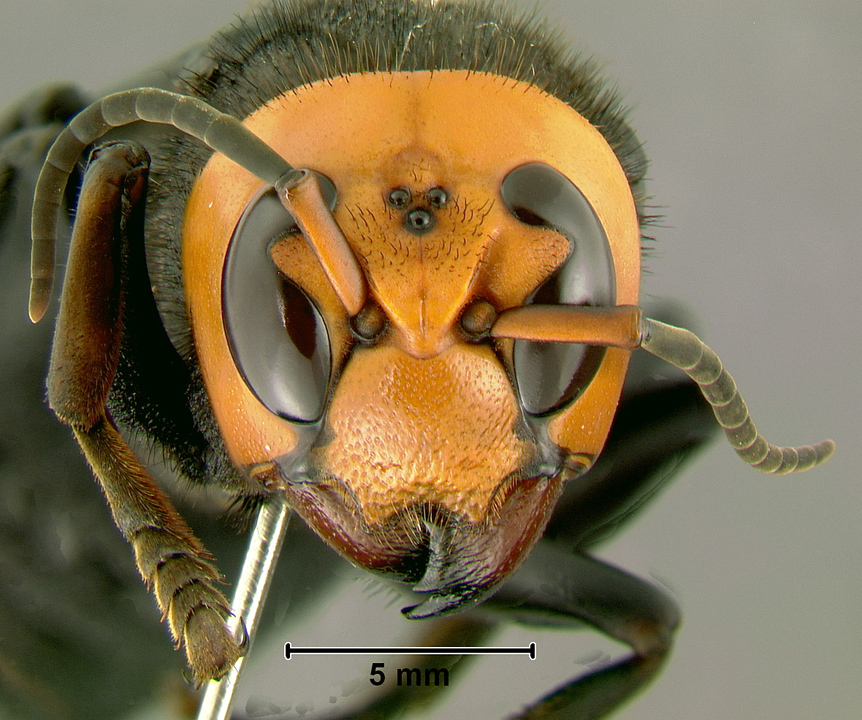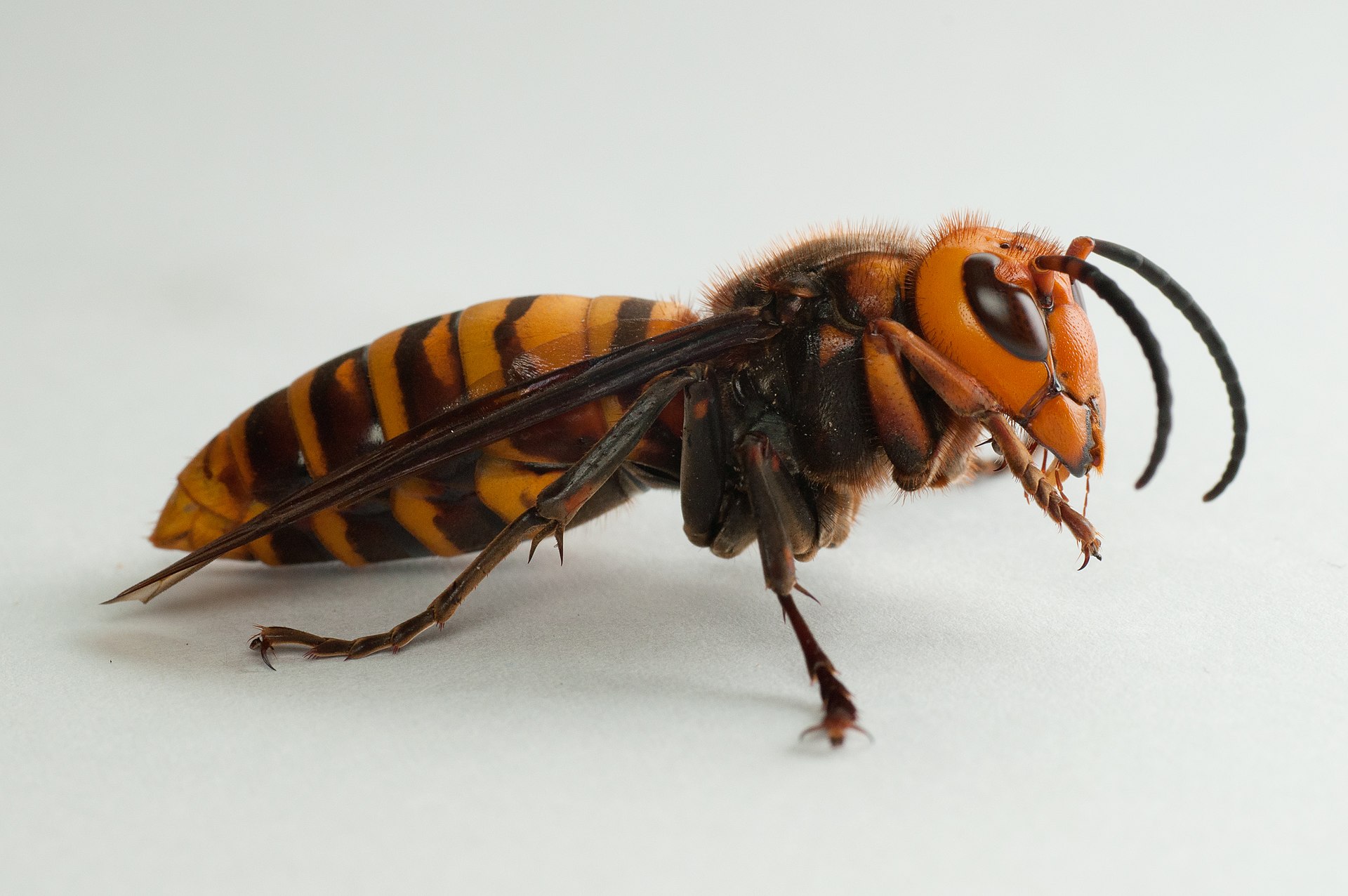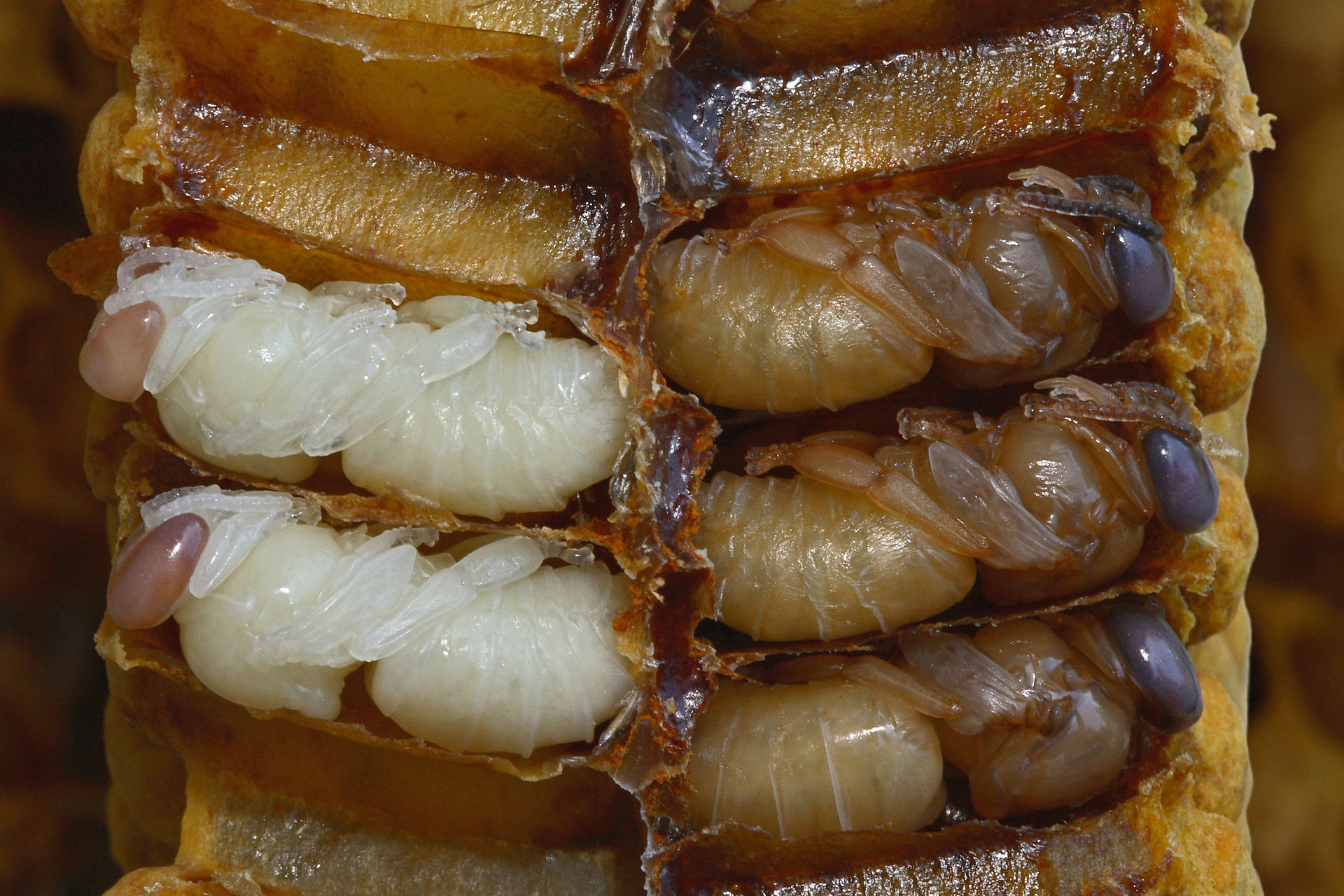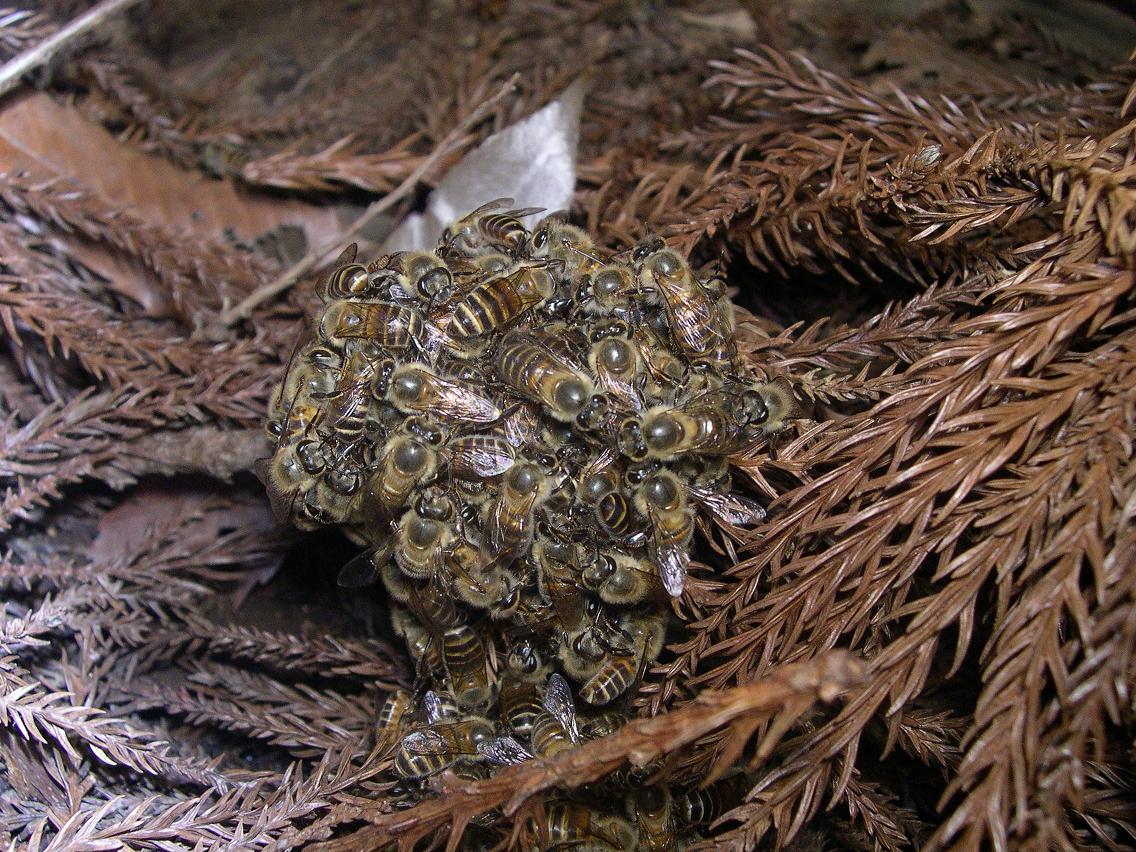Recently, towards the tail end of year 2019, in the United states, the Pacific Northwest received an unusual guest from Asia. The uninvited guest find its way to an apiary. Damages was done at the apiary by the invading guest. The farmer got to his farm late enough that he couldn't save his bees from the predator.
The invaders ensure that the whole bees in the hive were completely destroyed with their head torn apart from their body. All that the farmer saw was carcase of the severed bees body on the ground. The invader has completely annihilate the bees in the hive visited. All thanks to the invaders Asian giant hornet.(Vespa mandarinia)
What is Vespa mandarinia

Vespa mandarinia known as Asian giant hornet,(AGH) is the known largest specie of hornet that originate from the Eastern Asia most especially the temperate and Tropical eastern Asia. They predominantly dwell in the low mountains and as well as in the forest. It is also well adapted to this same conditions in the Pacific Northwest of North America, more reason why it could survive there possibly after it has been introduced there deliberately or unknowingly through shipment to the United States. They can hardly be found in the high mountains and plains.
This insect belongs to the order
 )
)Male_Vespa_mandarinia CC BY-SA 4.0,
hymenopterans which also include other insects such as bees, (its main prey),sawflies, wasp and ants. Most of the insects in this group are very useful as pollinator and pest control.
Vespa mandarinia is a social hornets, that uses its stingers for defence (the females). The social hornets are very aggressive and intimidating. However, in spring (using northern meteorological season) time like this,when flower blooms and trees reproduce, they are not very aggressive because food is readily available. The case is not the same in late summer when the weather is dry, and there is high request for protein to feed their larvae.
Vespa mandarinia Weapon
The weapon of destruction possessed by Vespa mandarinia is called stinger which is about 6mm in lenght. The stinger is peculiar to all hymenopterans. Its a modified ovipositor which its primary function is for laying eggs. So obviously, it is possessed by females alone. The stinger in them, better known as ovipositor is used to plopped egg into their prey. This ovipositor when used to attack, it completely immobilize the prey especially human with the feeling of hot nail driven into the body.
Effect of stinger on human
Asian giant hornet does not really sting human without proper warning. The insect minds its own business especially when on the search for food. They only attack human when the latter comes near their nest to disturbed them. The insect always try to avoid human. Before they descend on human, man would have deliberately ignored sound made by the insect mandible. Interestingly,the venom of honey bee is more toxic when compared to that of giant hornet, but the difference between the two is that honey bee only sting once while giant hornet can sting several times, and the effect of the venom could be life threatening.
Venom composition and effect on human
The venom of this insect has been studied to contain acetylcholine (a neurotransmitter) and a compound which mediate itching better known as histamine. Another component is kinins a polypeptides of –18 amino-acid residues which is a neurotoxin in the insect venom. A component of interest again is mastoparan a polypeptide and an enzyme phospholipase. All these component are in the venom and work together to suppress human immune system and thereby giving way for quick spread of the inflammation caused by the sting. Blood and muscle cells are seriously attacked as a result of synergetic action of all the chemicals present in the venom. Kidney failure, respirative failure and liver dysfunction are all imminent when an individual is sting. Japan annually experience 30-50 death as a result of Asian giant hornet sting. Though the death always result because of anaphylactic reactions rather than toxicity. Some of the reactions may include, itching rash on skin, swollen throat or tongue,light headedness and many more. All these could be experienced withing minutes or hours after sting. These hornets can attack several times, which means they can deposit large dose of the venom in the human body when they attacked. On United States social media , they called Asian giant hornet as murder hornet Further reading on effect of AGH sting on human click here
Attack on bee colony
The attack of giant hornet on honeybee colony is a coordinated attack. It is an assault on the bee colony that leads to colossal loss of an entire colony. The attack can be said to be a three stage coordinated one.
stage one
A lone attack where just one giant hornet goes to a nearby honeybee hive between 2km-7km distance from their own colony. On reaching the honeybee colony, it will attack a single bee worker at the entrance of the hive, ripe off its head at the thoracic segment into a paste and head back to its own nest to feed their own larvae. Since they are social insect, they communicate and head back to where the one that carry out the lone attack came from to carry out a major slaughter phase.
stage two.
At stage two, a group of 20-30 giant hornet carry out what is called slaughter. They destroy thousands of honey bee workers who are defenceless against the attackers. They rip off their heads one after the other until they are done with the workers manning the beehive entrance.
stage three

Once the hive is open to invasion, the abandoned honeybee larvae and pupae becomes bee-brood paste in the mouth of the invasive hornet. Withing hours a beehive which was once full of activities becomes a ghost town
Its so pathetic that the western honeybee Apis mellifera ligustica lacks defense mechanism unlike the Japenese honeybee Apis cerana japonica which has evolved to developed defense method against the Asian giant hornet and other invading insect.
The Japanese honeybee forms what is called Hot defensive ball against the invader. How do they do this? As soon as the invading hornet enter the hive, the bees quickly form a ball around the hornet.

They generate heat up to 46°C with the aid of their flight muscles. This they normally do to heat up their hive during cold. So they form ball round the hornet. The formation of the ball also elevate the amount of carbon iv oxide withing the ball. The hornet withing the ball can't survived the two conditions while the horneybee surrounding it can survive both increase in the amount of carbon iv oxide and temperature raise up to 50°, although some of the horneybee may not survive as they also die along, but they are able to prevent the invader from achieving its mission.
The history of Asian giant hornet into North America will not finish without mentioning where they were first sighted which is the British Columbia's Vancouver island in Canada pacific coast in mid-August 2019. Three of the Asian giant hornets were first sighted there. The government agency raised an awareness about the invasion of the hornets. They warned that the number might increase by spring when the queen will appear. The warning was sounded so that proactive measure would be taken to contain the number of the hornet.
## Conclusion The consequence of the increase in the number of **_Murder hornet_** could affect the safety of human life and also reduce the honey yield annually in the affected part of the country.
References
http://entnemdept.ufl.edu/creatures/MISC/BEES/Vespa_mandarinia.html
https://www.livescience.com/murder-hornets-in-washington-state.html
https://en.m.wikipedia.org/wiki/Apis_cerana_japonica
https://en.m.wikipedia.org/wiki/Western_honey_bee
https://www.tandfonline.com/doi/full/10.1080/15563650701664871
You can join stemsocial on Discord
Wow..... this is a very great and detailed research on Asian Giant Hornet.
I'm scared of both the honey bees and the hornet. I don't even care about the difference whether one stings just once and/or continuously. Lol.
This is a good read, @steepup.
Thanks for coming around here. Hornet sting is much more dangerous.
Congratulations @steepup! You have completed the following achievement on the Hive blockchain and have been rewarded with new badge(s) :
You can view your badges on your board And compare to others on the Ranking
If you no longer want to receive notifications, reply to this comment with the word
STOPTo support your work, I also upvoted your post!
Do not miss the last post from @hivebuzz:
A bite from these insects must hurt like hell
Thanks for your contribution to the STEMsocial community. Feel free to join us on discord to get to know the rest of us!
Please consider supporting our funding proposal, approving our witness (@stem.witness) or delegating to the @stemsocial account (for some ROI).
Thanks for using the STEMsocial app and including @stemsocial as a beneficiary, which give you stronger support.
I didn't know about this hot ball defensive mechanism. That is great. I hate hornets... :(
PS: please note a small problem with your HTML code:
Please use this for the first image:
<div class="pull-left"><center><br/><em><a href="https://commons.wikimedia.org/w/index.php?curid=63832922"><sup> Male_Vespa_mandarinia CC BY-SA 4.0, </sup></a></em></center></div>``` There was a faulty HTML `img` tag in there.Thanks correction noted. I will do that with my next post on the app.Thanks for coming around too out of your busy schedule.
You could also edit this post so that it would display nicely already, couldn't you?
@Lemouth, thanks don't mind me. I have done the correction.
Wow! What an article. I missed this. Pretty amazing. I'm reblogging even though it's out of the voting window because I think people should read this.
Thanks for coming around around @agmoore, i appreciate your visit and kind words. I appreciate the token sent as well.